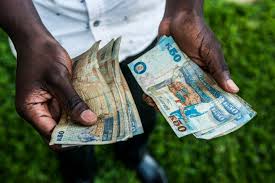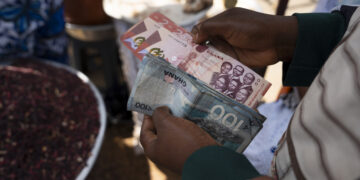Among Africa’s Top Performing Currencies — the Zambian Kwacha
Zambia’s currency is enjoying its best run in nearly two years, buoyed by a surge in copper output and tighter monetary discipline.
By Bonface Orucho, bird story agency
The kwacha of Zambia has soared to the highest point in almost two years on the hope that the copper industry will recover and investor confidence in the second-largest producer of the metal will be restored in Africa. Early October saw the currency gain 0.7% to approximately 22.76 to every US dollar, increasing its year-to-date earnings to approximately 23, as per Bloomberg figures on October 10.
“It has climbed the most among African currencies so far this year,” according to a Bloomberg report.
According to the World Bank’s Africa’s Pulse report for October 2025, the Zambian kwacha is Africa’s second highest earning currency currency, appreciating 16 percent year-to-date. The report links this to debt restructuring progress, lower oil import costs, and a temporary rise in U.S. dollar supply from higher domestic currency demand during tax season. Other expert analyses show that behind the rise is a convergence of forces: recovering copper production, stronger world prices and Bank of Zambia reforms that have reintroduced liquidity and confidence to the foreign exchange market.
“The combination of stronger mining output, disciplined monetary policy, and improved FX transparency has convinced the market that Zambia’s fundamentals are finally stabilising,” said Dennis Mumba, an economist at the Zambia Institute for Policy Analysis and Research (ZIPAR).
The Bank of Zambia had tightened the money conditions and increased the forex market transparency over the last year. It kept the policy rate at 12.5% throughout 2024, an indication that it was determined to maintain inflation in check, which dropped above 12% in 2023 to about 8% at mid-2025, and progressively restored international reserves. Simultaneously, the central bank has overhauled foreign-exchange activities to enhance predictability and liquidity. It proposed a weekly FX auction calendar system, increased reporting on export retention requirements by mining companies, and increased monitoring of the foreign position of the banks to prevent speculative trading. These, along with the 2025 Currency Market Directives that require exporters to repatriate proceeds within a specific timeframe, have strengthened the interbank market and enhanced FX availability.
“The central bank’s reforms have been critical,” Mumba said. “By tightening rules on export proceeds and restoring interbank liquidity, the Bank of Zambia has reduced speculation and improved the credibility of the kwacha. It’s a signal that policy coherence is returning.”
<script src=”https://bird.africanofilter.org/hits/counter.js” id=”bird-counter” data-counter=”https://bird.africanofilter.org/hits/story/?id=2518&slug=zambia-s-copper-comeback-is-breathing-new-life-into-the-kwacha” type=”text/javascript” async=”async”></script>
It is worth mentioning, however, that it represents the radical reversal of a nation that only a year before was grappling with power shortages caused by drought, derailed mining production, and financial uncertainty associated with its long-standing debt cleanup operation. According to Zambia’s Ministry of Mines, copper production rose by about 30% year on year in the first quarter of 2025, reaching roughly 224,000 metric tons from 173,000 tons in the same period last year, driven largely by higher output from Konkola Copper Mines and Mopani Copper Mines.
However, production dipped in the second quarter, falling around 4% from the first quarter to about 215,000 tons, putting the government’s one-million-ton annual target at risk, according to official data released in August. The recovery is also being led by new investments and restarted operations by First Quantum Minerals, Barrick Gold, and Vedanta Resources, and the government hopes the recovery will push the annual output to the one-million-ton range.
The global context has also worked in Zambia’s favour. The International Copper Study Group projects a refined copper deficit by 2026 due to rising demand for electric vehicles and renewable infrastructure. Benchmark prices on the London Metal Exchange have climbed about 15% over the past six months, sustaining export revenues and supporting the kwacha.
“Foreign investors are starting to price Zambia differently. The perception that the country is moving past its debt and policy uncertainty is driving renewed inflows, but maintaining that sentiment will require consistent reform follow-through,” Mumba added.
The Bank of Zambia has made steps to enrich those profits with policy changes. The latest statement by the bank revealed that its 2025 Currency Market Directives, which mandate exporters to repatriate proceeds and ensure greater transparency in interbank transactions, have enhanced liquidity and prevented speculative pressure on the currency. For the Hakainde Hichilema administration, the timing is strategic. The kwacha’s rally comes as the government looks to stabilise inflation, which eased to 8.3% in September, and rebuild reserves eroded during the debt crisis. A stronger currency also lowers import costs, offering relief to urban households and import-dependent businesses.
Still, not everyone benefits. Exporters outside the mining sector, particularly in agriculture and manufacturing, face thinner margins when the kwacha appreciates. For them, the stronger currency makes their products more expensive abroad. Economists also warn that the rally may not be entirely structural.
“Commodity-linked currencies often move faster than fundamentals,” said Mumba. “A sudden dip in copper prices or production disruptions could quickly reverse the trend.”
Those concerns are not unfounded. Zambia’s mines remain vulnerable to power fluctuations, as seen during the drought early this year that cut hydroelectric output and forced rationing. Mining logistics and transport infrastructure also lag behind regional peers, adding to operational costs. Nonetheless, the broader regional picture is reinforcing Zambia’s position. While the South African rand and Botswana’s pula have seen mixed performances against the dollar this year, Zambia’s currency has outpaced both, highlighting investor confidence in the country’s copper-backed recovery story.
According to the Bank of Zambia, stronger export receipts are improving the balance of payments, helping rebuild foreign reserves that had fallen to US$2.5 billion in early 2024. The IMF, in its latest review, noted Zambia’s “steady macroeconomic improvement” under its Extended Credit Facility programme, pointing to fiscal consolidation and improved mining output as key drivers.
According to Mumba, that macro turnaround could unlock new investment flows into the mining and manufacturing sectors.
“The government has approved new exploration licenses and is courting capital for smelting, energy, and logistics infrastructure critical for sustaining long-term output.”
For miners, the improved sentiment is tangible. First Quantum Minerals, which operates the Sentinel and Kansanshi mines, recently announced a US$1.3 billion expansion plan. Vedanta Resources, after regaining control of Konkola Copper Mines in 2024, has pledged to invest US$1 billion to boost output over the next five years.
“These investments are coming at a moment when Zambia’s currency strength reflects real operational gains,” said Paul Kabuswe, Zambia’s Minister of Mines, in an interview with state media. “Our goal is to turn short-term momentum into structural growth.”
According to Mumba, however, across Africa, Zambia’s rally adds a new dimension to the continent’s economic story.
“It underscores how commodity-driven recoveries, when paired with credible reforms and investor confidence, can yield tangible financial stability. Yet it also exposes the fragility of economies tethered too tightly to a single export.”
bird story agency








